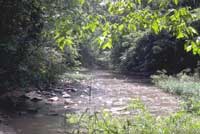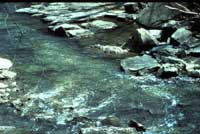
Hey, Tortuga Tex, Tell Me More About Riffles
Riffles are areas of a river or creek with shallow water that flows fast over gravel and rocks. They resemble little rapids, only rapids are deeper with a more powerful water flow and usually on wider river segments. Aquatic Organisms All sorts of organisms live under the water and are commonly found in riffles and other aquatic environments. You can learn more about aquatic ecosystems. Riffle Visitors Herons, kingfishers and other fish-eating birds come to sample the fish and crayfish that are often abundant in riffles. Beavers and muskrats make their homes along streambeds. During migration, songbirds rest in vegetation along stream corridors. Many songbirds will remain and raise their offspring during summer. Because riffles and streams are frequently lined with trees and other vegetation, deer, raccoons, fox and other animals use the areas for cover and foraging for food. Many reptiles, such as turtles and snakes, thrive in riparian (along rivers) areas. The endangered Concho water snake requires riffle habitat to grow. Loss of habitat is the major factor contributing to the decline in its populations. Amphibians such as salamanders and frogs mate and lay eggs in the water. 
Anglers like Riffles Anglers or fishermen know about riffles. That's why they fish them. They know that fish will be found there because there is food for them to eat. They may not be the biggest fish, (those may be downstream in the runs and pools), but riffles are easy to wade and since they are shallow and clear, it's easier to see the fish. If you like to fish, it's important to learn about aquatic habitats because then you'll know where to find the fish you want to catch. Threats to Riffles Some things can have a negative impact on riffles. Anything that alters the flow of the river or stream; water development projects, stream diversions, and aquifer pumping can affect the riffles downstream. Also removal of vegetation along streams and rivers can be harmful because it can allow silting of riffles. Silting occurs when fine sand, soil and other particulates enter the stream or riffle unfiltered. If the silt covers the gravel bottom, fish and frog eggs can smother. If a lot of silt accumulates it can clog the riffle and alter the flow of the water. Another impact to riffles that is more direct, is when recreational boaters drag canoes or kayaks over riffles and recreational vehicles cross rivers and streams at riffles, they can physically change the flow of the water by displacing the gravel substrate. What are a run, riffle and pool? [top] |